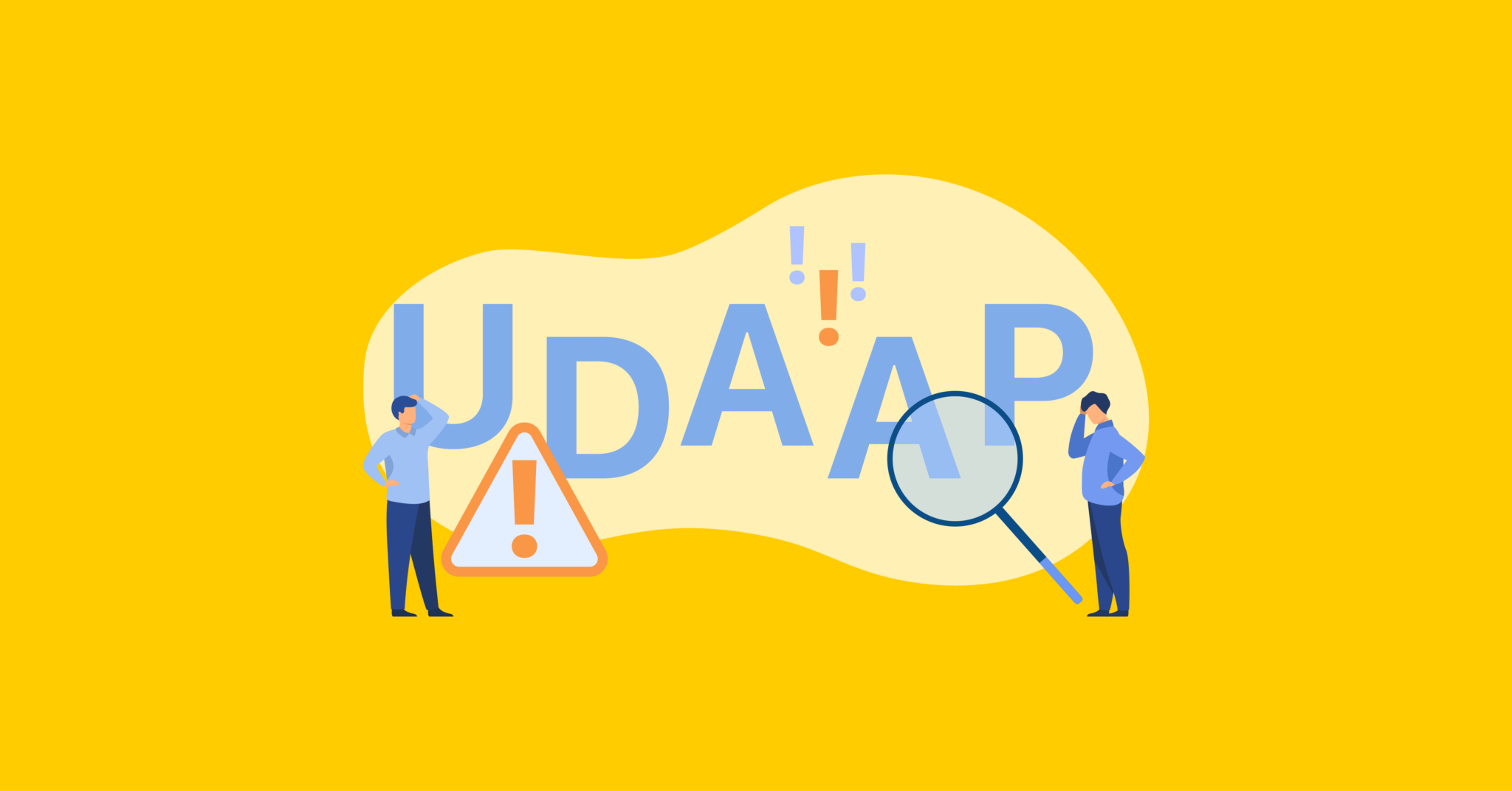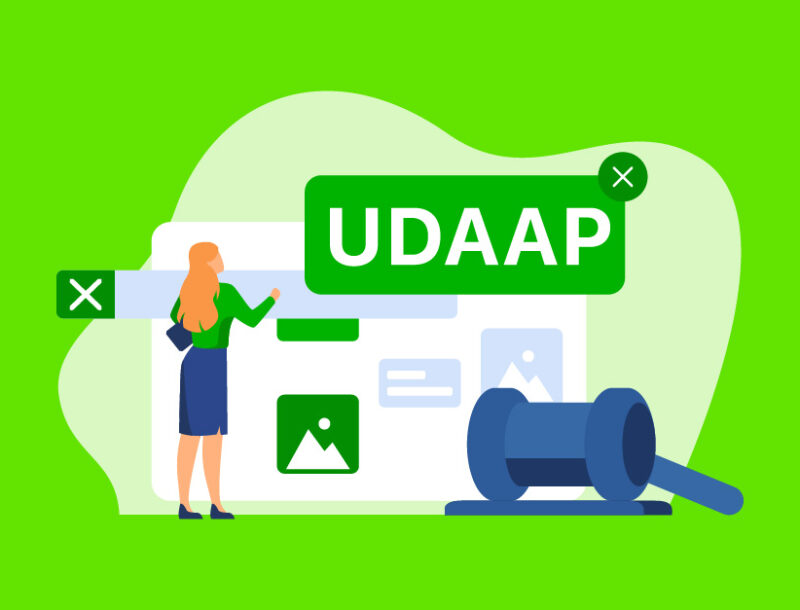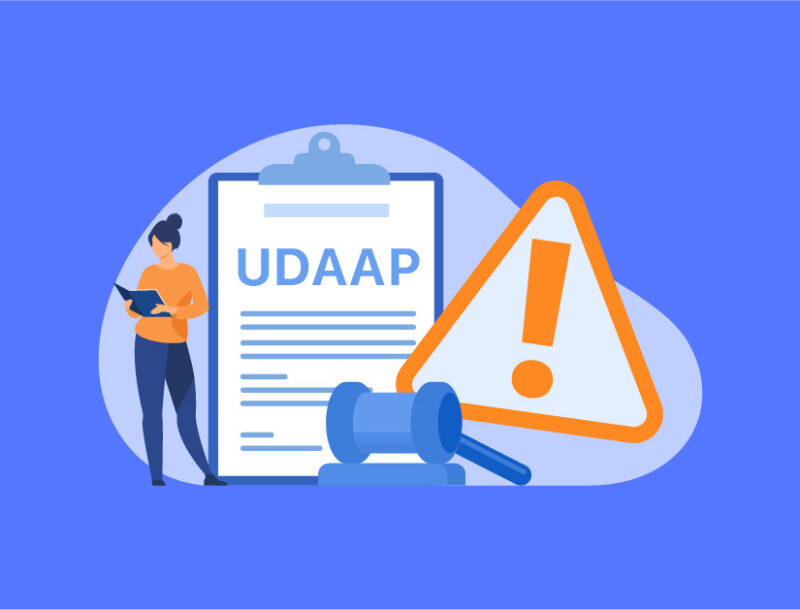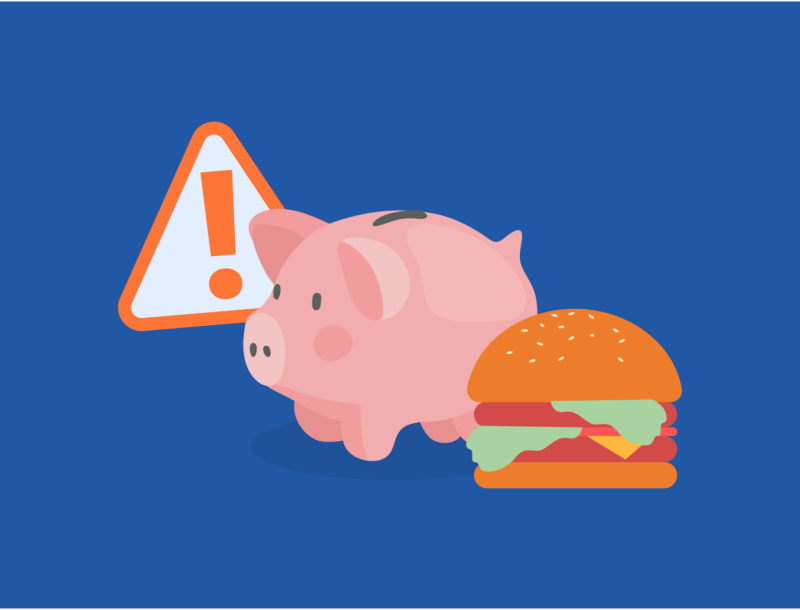What You Need to Know About UDAAP Compliance

UDAAP compliance is complex, but its purpose is simple: to protect consumers from being harmed by the actions of consumer finance organizations.
This article covers what UDAAP compliance is, why it’s important, who regulates UDAAP compliance, the distinction between unfair, deceptive, and abusive, violation examples, and how to avoid UDAAP compliance risk.
- What is UDAAP compliance?
- Why is UDAAP compliance important for consumer finance companies?
- Which regulators enforce UDAAP compliance?
- What’s the difference between an unfair, deceptive, and abusive practice?
- What are examples of UDAAP violations?
- How can consumer finance companies avoid UDAAP compliance concerns?
What is UDAAP compliance?
UDAAP compliance ensures that an organization’s marketing materials and practices adhere to a set of government regulations designed to protect consumers from unethical or misleading tactics that cause financial harm, known as Unfair, Deceptive, or Abusive Acts or Practices (UDAAP).
Why is UDAAP compliance important for consumer finance companies?
UDAAP compliance is important for consumer finance companies to:
- Protect consumers: By ensuring compliance with UDAAP, consumers are protected from financial harm
- Avoid enforcement actions: Failure to comply with UDAAP regulations can result in enforcement actions, costly penalties, and reputational damage
- Maintain a positive brand reputation: Companies that engage in unfair, deceptive, or abusive practices can quickly lose consumer trust and face significant negative publicity
- Gain a competitive advantage: Companies that prioritize consumer protection through UDAAP compliance are more likely to attract and retain customers, and they can set themselves apart from competitors who do not
Which regulators enforce UDAAP compliance?
Depending on the type of financial institution and the specific product or service involved, UDAAP compliance is monitored and enforced by a variety of regulators at the federal and state levels:
- Consumer Financial Protection Bureau (CFPB): The CFPB is the primary regulator responsible for enforcing UDAAP regulations for most consumer financial products and services
- Federal Trade Commission (FTC): The FTC also has authority over UDAAP regulations and is responsible for enforcing these regulations for non-bank financial institutions, such as debt collectors and credit reporting agencies
- Office of the Comptroller of the Currency (OCC): The OCC has authority over UDAAP regulations for national banks and federal savings associations
- State Regulators: Many states have their own UDAAP regulations and regulators that oversee compliance with these regulations for state-chartered banks and other financial institutions
What’s the difference between an unfair, deceptive, and abusive practice?
UDAAP compliance can be complex. For the sake of simplicity, here are high-level explanations of what’s considered unfair, abusive, or deceptive, according to the CFPB.
Unfair
An act or practice is unfair when:
- It causes or is likely to cause substantial injury to consumers
- The injury is not reasonably avoidable by consumers
- The injury is not outweighed by countervailing benefits to consumers or to competition
Deceptive
A representation, omission, act, or practice is deceptive when:
- The representation, omission, act, or practice misleads or is likely to mislead the consumer
- The consumer’s interpretation of the representation, omission, act, or practice is reasonable under the circumstances
- The misleading representation, omission, act, or practice is material
Abusive
An abusive act or practice:
- Materially interferes with the ability of a consumer to understand a term or condition of a consumer financial product or service
- Takes unreasonable advantage of:
- A lack of understanding on the part of the consumer of the material risks, costs, or conditions of the product or service
- The inability of the consumer to protect their interests in selecting or using a consumer financial product or service
- The reasonable reliance by the consumer on a covered person to act in the interests of the consumer
What are examples of UDAAP violations?
There are numerous types of UDAAP violations, which vary greatly depending on the nature of the marketing material, the types of products or services offered, and so on.
Deceptive UDAAP Violation Example
An example of a deceptive UDAAP violation would be a lender advertising a loan with a “low” interest rate of 5%—but failing to disclose that there are other fees (such as application fees, for example) that significantly increase the total cost of the loan.
This could be considered a deceptive act because it could mislead consumers into making a decision based on incomplete or false information. Consumers may believe that they are getting a good deal when, in reality, the total cost of the loan is much higher than advertised.
Unfair UDAAP Violation Example
An example of an unfair UDAAP violation would be a lender offering a loan to a low-income borrower with a high interest rate and charging excessive fees, knowing that the borrower is unlikely to be able to repay the loan. This could result in the borrower being trapped in a cycle of debt, with the lender profiting from the borrower’s financial hardship. (Note: This may also be considered deceptive if the lender failed to disclose these interest rates and fees in its marketing materials and communications.)
This could be considered an unfair practice because it takes advantage of a consumer’s vulnerable financial situation and lack of access to better loan options. The lender is exploiting the borrower’s desperation and financial need for their own profit, rather than providing fair and affordable loan options.
Abusive UDAAP Violation Example
An example of an abusive UDAAP violation would be a credit card company offering a low introductory interest rate for the first six months, but failing to disclose in its marketing materials and communications that the rate will increase significantly after the introductory period.
This could be considered an abusive practice because it could mislead consumers into signing up for a credit card that they cannot afford to pay off once the introductory period ends, ultimately resulting in the consumer incurring large amounts of debt and potentially facing financial hardship.
By failing to disclose the true cost of the credit card, the company is engaging in an abusive practice that takes advantage of consumers’ lack of knowledge or understanding about credit card terms and fees.
How can consumer finance companies avoid UDAAP compliance concerns?
Consumer finance companies can avoid UDAAP compliance concerns with a robust and comprehensive UDAAP compliance program, which can include:
- Building and documenting policies and procedures for UDAAP compliance, including marketing and advertising guidelines, consumer complaint management, communication policies, third-party management, and so on
- Conducting regular UDAAP risk assessments to proactively identify and mitigate business risks, as well as to prioritize resources and budget
- Conduct regular internal UDAAP compliance training programs for employees, which can include a review of policies, recent enforcement actions, best practices, prohibited language and content, and more
- Have a clear action plan for instances of non-compliance by an employee, partner, affiliate, or third party
- A process to monitor for UDAAP compliance across the multiple marketing channels and platforms that individuals may be using
- A omni-channel compliance software or tool to help monitor your brand across marketing channels and third parties


